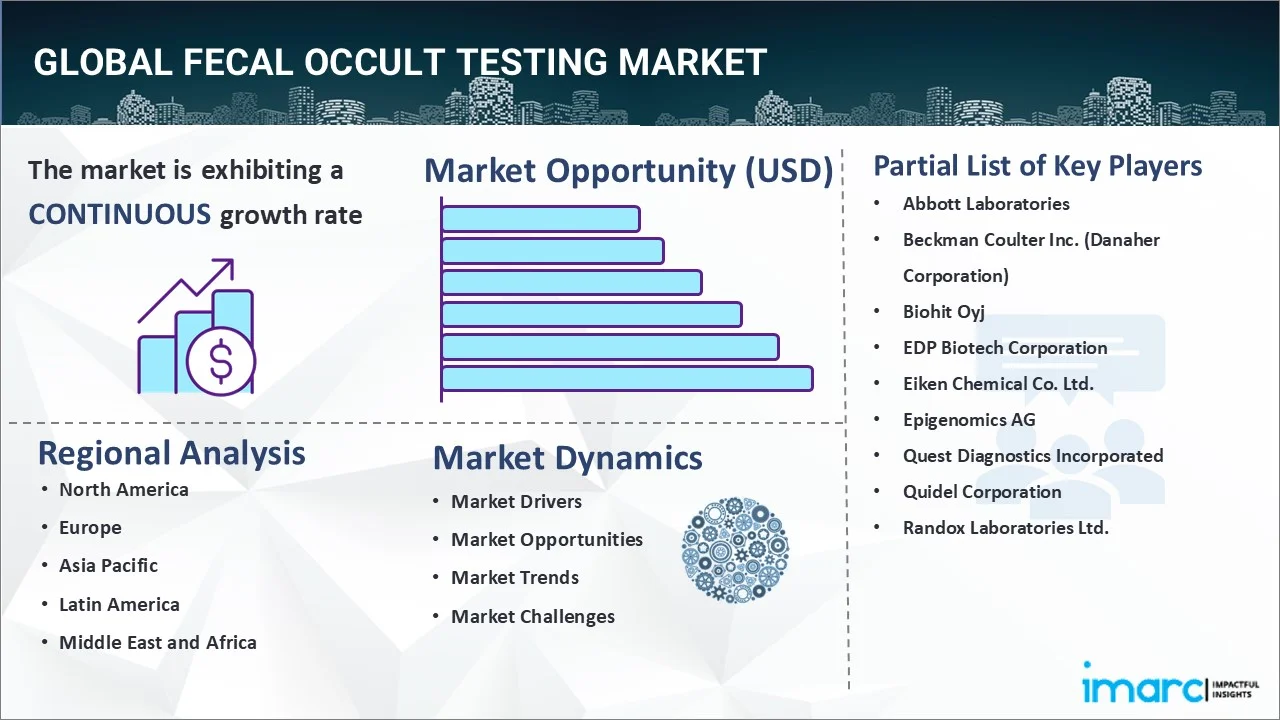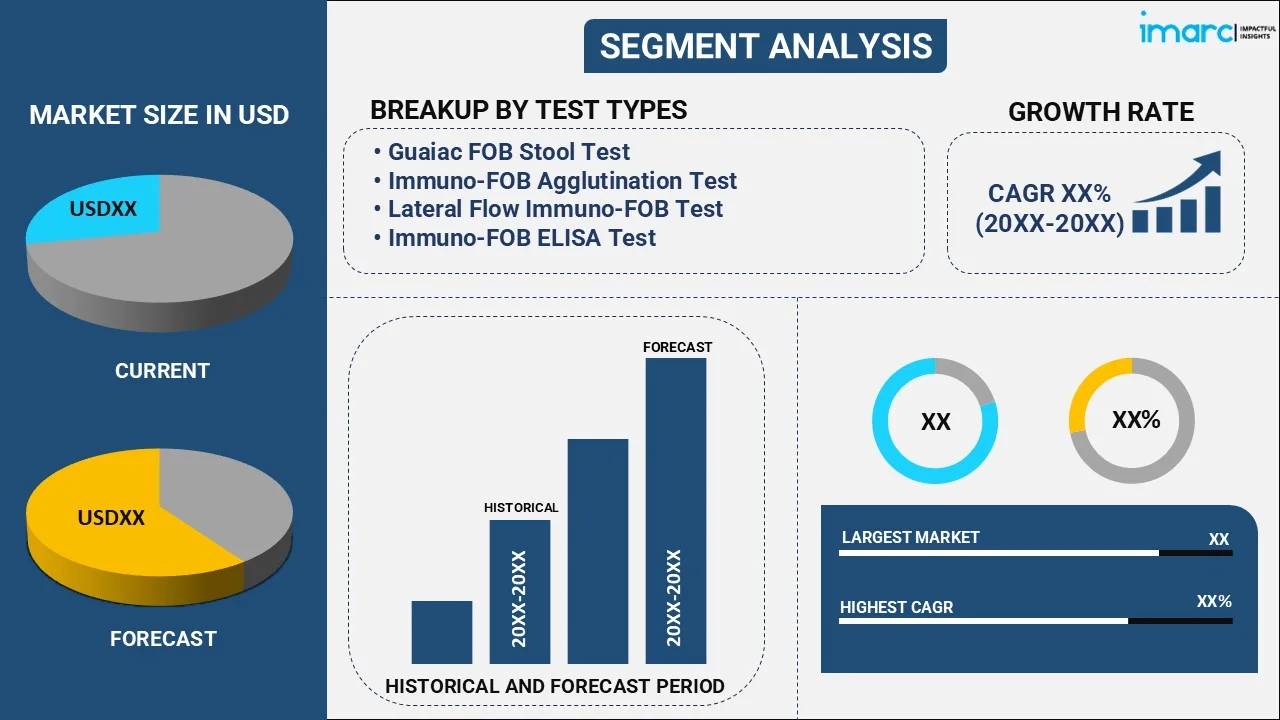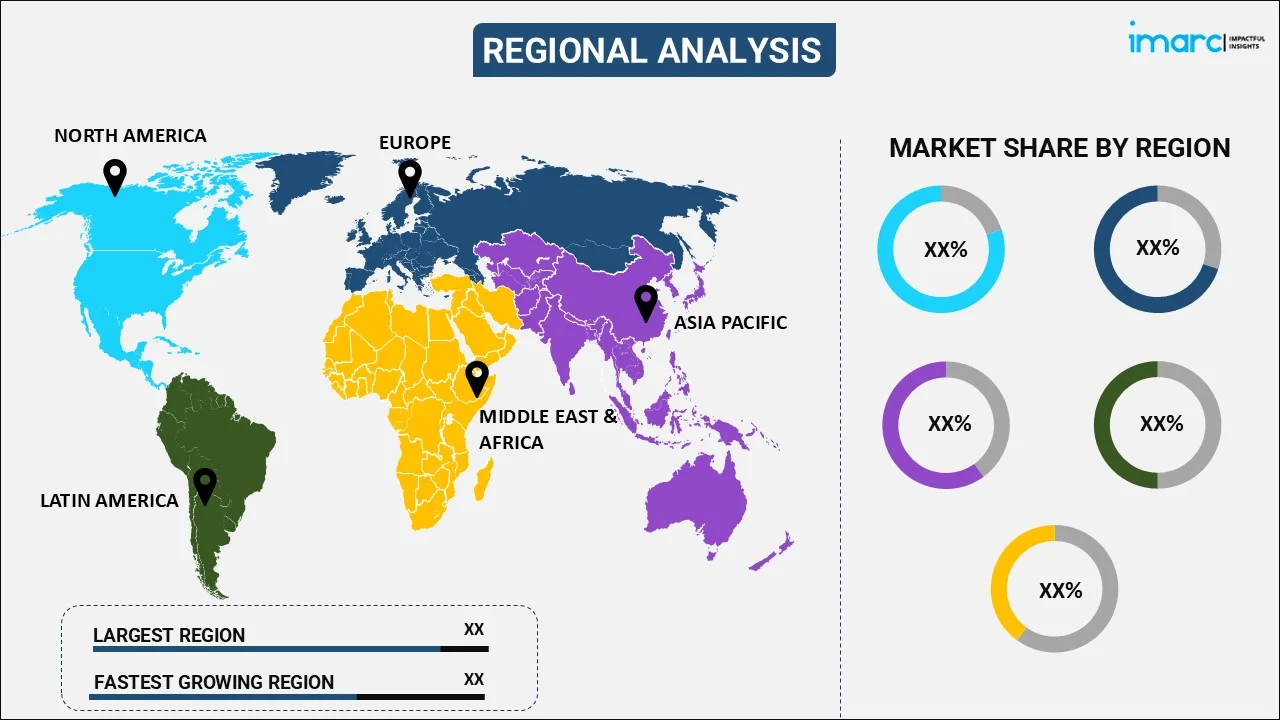
Fecal Occult Testing Market Report by Test Type (Guaiac FOB Stool Test, Immuno-FOB Agglutination Test, Lateral Flow Immuno-FOB Test, Immuno-FOB ELISA Test), End User (Hospitals, Clinical Diagnostic Laboratories, Physician Office Laboratories), and Region 2025-2033
Fecal Occult Testing Market Size:
The global fecal occult testing market size reached USD 1,426.9 Million in 2024. Looking forward, IMARC Group expects the market to reach USD 2,142.2 Million by 2033, exhibiting a growth rate (CAGR) of 4.15% during 2025-2033. The rising prevalence of colorectal cancer, significant advancements in non-invasive testing technologies, increasing awareness and screening programs, growing government initiatives for early cancer detection and prevention, and rising aging populations are some of the major factors propelling the market growth.
|
Report Attribute
|
Key Statistics
|
|---|---|
|
Base Year
|
2024
|
|
Forecast Years
|
2025-2033
|
|
Historical Years
|
2019-2024
|
|
Market Size in 2024
|
USD 1,426.9 Million |
|
Market Forecast in 2033
|
USD 2,142.2 Million |
| Market Growth Rate 2025-2033 | 4.15% |
Fecal Occult Testing Market Analysis:
- Major Market Drivers: The increasing prevalence of colorectal cancer, which necessitates early and regular screening represents a major driver of the market. Public health initiatives and government programs are promoting awareness and the importance of early detection, further boosting demand.
- Key Market Trends: The rising shift towards at-home testing kits, which offer convenience and privacy to patients represents key trends in the market. Innovations in test accuracy and ease of use are making these kits more popular. The increasing integration of digital health technologies is enhancing patient compliance and data management, providing real-time results and better tracking.
- Geographical Trends: North America accounted for the largest region in the fecal occult testing market growth. The high colorectal cancer prevalence, extensive public health campaigns, advanced non-invasive testing technologies, an aging population, and increasing awareness and screening initiatives promoted by government programs and healthcare providers.
- Competitive Landscape: Some of the major market players in the fecal occult testing industry include Abbott Laboratories, Beckman Coulter Inc. (Danaher Corporation), Biohit Oyj, EDP Biotech Corporation, Eiken Chemical Co. Ltd., Epigenomics AG, Quest Diagnostics Incorporated, Quidel Corporation and Randox Laboratories Ltd., among many others.
- Challenges and Opportunities: The market faces several challenges including the stigma and discomfort associated with stool sample collection, leading to low patient compliance. However, the market also faces various opportunities such as advancements in non-invasive testing technologies, making the process more patient-friendly and reliable.

Fecal Occult Testing Market Trends:
Increasing Prevalence of Colorectal Cancer
The rising incidence of colorectal cancer underscores the need for early detection and regular screening, significantly boosting the demand for fecal occult tests. An early diagnosis is crucial for effective treatment, making these tests vital in healthcare strategies. According to the Colorectal Cancer Alliance, colorectal cancer remains one of the most common cancers. The American Cancer Society estimates that 152,810 people in the U.S. will be diagnosed with colorectal cancer in 2024, and 53,010 will die from the disease. The number of people diagnosed has steadily declined since the mid-1980s due to increased screening and changing lifestyles. In the U.S., about 10% of colorectal cancer cases are diagnosed in people under 50. Black Americans have the second-highest mortality and incidence rates of colorectal cancer in the U.S. They are 35% more likely to die from colorectal cancer and 15% more likely to develop it than non-Hispanic whites. This is further boosting the fecal occult testing market statistics significantly.
Significant Technological Advancements
The growing technological advancements have revolutionized fecal occult testing. Innovations in non-invasive testing methods are enhancing accuracy, convenience, and patient compliance. These improvements make the tests more user-friendly and reliable, encouraging broader adoption among both patients and healthcare providers, thus contributing to the market growth. For instance, The Clearview™ One Step Fecal Occult Blood Test Device (Feces) is a rapid test to qualitatively detect low levels of FOB. The test uses a double antibody sandwich assay to selectively detect FOB at 50 ng/ml or higher, or 6 µg/g feces, and unlike guaiac assays, the accuracy of the test is not affected by the diet of the patient. Similarly, in August 2023, Thermo Fisher Scientific the world leader in serving science, announced the commercial launch of the EXENT® Solution, after receiving IVDR certification. The EXENT solution is a fully integrated and automated mass spectrometry system designed to transform diagnosis and assessment for patients with monoclonal gammopathies, including multiple myeloma which, according to the World Health Organization in 2020, is the second most prevalent blood cancer worldwide. The EXENT Solution is now commercially available in the following countries: Belgium, France, Germany, Italy, the Netherlands, Spain, and the United Kingdom. This is expected to fuel the fecal occult testing market forecast over the coming years.
Growing Government and Public Health Initiatives
The extensive awareness campaigns and screening programs by health organizations and governments are increasing public awareness and participation in regular colorectal cancer screenings. These initiatives aim to reduce cancer mortality rates through early detection, further driving the market growth. For instance, Colorectal Cancer Awareness Month is an annual observance held throughout the month of March. It was established in 2000 as an annual opportunity to raise awareness of colorectal cancer (CRC) and to promote research into its cause, prevention, diagnosis, treatment, survivorship, and cure. The goal is to support those affected by CRC and encourage health-promoting behaviors such as getting screened, staying active, and eating a balanced diet. “80% in Every Community” is an initiative from the National Colorectal Cancer Roundtable (NCCRT) that emphasizes these goals and aims to achieve 80% CRC screening rates in every community (NCCRT, 2021).
Fecal Occult Testing Market Segmentation:
IMARC Group provides an analysis of the key trends in each segment of the market, along with forecasts at the global, regional, and country levels for 2025-2033. Our report has categorized the market based on test type and end user.
Breakup by Test Type:

- Guaiac FOB Stool Test
- Immuno-FOB Agglutination Test
- Lateral Flow Immuno-FOB Test
- Immuno-FOB ELISA Test
Immuno-FOB ELISA Test accounts for the majority of the market share
The report has provided a detailed breakup and analysis of the market based on the test type. This includes the Guaiac FOB Stool Test, Immuno-FOB Agglutination Test, Lateral Flow Immuno-FOB Test, and Immuno-FOB ELISA Test. According to the report, Immuno-FOB ELISA Test represented the largest segment.
The demand for the Immuno-FOB ELISA Test in the fecal occult testing market is driven by its high sensitivity and specificity in detecting colorectal cancer. This test's ability to accurately identify lower levels of occult blood enhances early diagnosis and treatment. Additionally, its non-invasive nature improves patient compliance. Growing awareness of colorectal cancer screening, coupled with advancements in immunoassay technology, further boosts its adoption. Government initiatives and public health campaigns also play a significant role in driving demand. For instance, in February 2023, Charles River Laboratories International, Inc. announced the launch of its first Enzyme-Linked Immunosorbent Assay (ELISA) Kit for the detection and quantitation of residual host cell proteins (HCP) in CHO-based biotherapeutics. Charles River’s HCP ELISA kit achieves industry-leading rates for sensitivity and specificity, reaching 0.1 ng/mL and 90 percent antibody coverage, respectively. This increase in sensitivity and specificity can be attributed to the unique chicken immunoglobulin Y (IgY) antibodies utilized.
Breakup by End User:
- Hospitals
- Clinical Diagnostic Laboratories
- Physician Office Laboratories
Hospitals holds the largest share of the industry
A detailed breakup and analysis of the market based on the end user have also been provided in the report. This includes hospitals, clinical diagnostic laboratories, and physician office laboratories. According to the report, hospitals accounted for the largest market share.
The demand for fecal occult testing in hospitals is driven by the need for early detection of colorectal cancer, improving patient outcomes through timely intervention. Hospitals leverage these tests due to their non-invasive nature, high accuracy, and cost-effectiveness. Increasing awareness and education about colorectal cancer screening among patients and healthcare providers also boosts demand. Additionally, supportive government policies and public health initiatives promoting regular screenings contribute to the growing use of fecal occult tests in hospital settings.
Breakup by Region:

- North America
- United States
- Canada
- Asia-Pacific
- China
- Japan
- India
- South Korea
- Australia
- Indonesia
- Others
- Europe
- Germany
- France
- United Kingdom
- Italy
- Spain
- Russia
- Others
- Latin America
- Brazil
- Mexico
- Others
- Middle East and Africa
North America leads the market, accounting for the largest fecal occult testing market share
The report has also provided a comprehensive analysis of all the major regional markets, which include North America (the United States and Canada); Europe (Germany, France, the United Kingdom, Italy, Spain, Russia, and others); Asia Pacific (China, Japan, India, South Korea, Australia, Indonesia, and others); Latin America (Brazil, Mexico, and others); and the Middle East and Africa. According to the report, North America represents the largest regional market for fecal occult testing.
The high colorectal cancer incidence, extensive public health campaigns promoting early detection, and increased healthcare spending are driving the market growth across the region. Advancements in non-invasive and more accurate testing technologies also boost demand. Additionally, an aging population, which is more susceptible to colorectal cancer, and strong government support for cancer screening programs further propel market growth. Increasing awareness and education about the importance of regular screening play a critical role in driving the market. According to the Centers for Medicare &Medicaid Services, U.S. healthcare spending grew 4.1% in 2022, reaching $4.5 trillion or $13,493 per person. As a share of the nation's Gross Domestic Product, health spending accounted for 17.3 %.
Competitive Landscape:
- The market research report has also provided a comprehensive analysis of the competitive landscape in the market. Detailed profiles of all major companies have also been provided. Some of the major market players in the fecal occult testing industry include Abbott Laboratories, Beckman Coulter Inc. (Danaher Corporation), Biohit Oyj, EDP Biotech Corporation, Eiken Chemical Co. Ltd., Epigenomics AG, Quest Diagnostics Incorporated, Quidel Corporation and Randox Laboratories Ltd.
(Please note that this is only a partial list of the key players, and the complete list is provided in the report.)
- The competitive landscape in the fecal occult testing market is characterized by the presence of numerous key players, including Abbott Laboratories, Siemens Healthineers, and Danaher Corporation. These companies focus on innovation, offering advanced non-invasive testing technologies to enhance accuracy and patient compliance. Additionally, investments in research and development for improved test efficiency and government approvals play crucial roles in maintaining a competitive advantage in this growing market. For instance, in June 2022, Meridian Bioscience, Inc. a leading global provider of diagnostic testing solutions and life science raw materials, announced today two new sample-specific master mixes, Lyo-Ready Direct DNA qPCR Stool Mix, and Lyo-Ready Direct RNA/DNA qPCR Stool Mix. These innovative master mixes improve the molecular detection of DNA and RNA from crude fecal specimens while allowing room temperature stabilization of diagnostic assays.
Fecal Occult Testing Market News:
- In December 2023, DiaCarta. Inc., a leading innovator in precision medicine diagnostic biomarker assays, announced that DiaCarta received US FDA 510(k) clearance for it's over the counter (OTC) at-home iColon Fecal Occult Blood Test (F0BT) that enables early detection of blood in stool at home, which is clinically relevant in gastrointestinal disorders end colorectal cancer.
- In February 2024, ColoTest®, an over-the-counter (OTC) at-home immunochemical fecal occult blood test, has been available by Reese Pharmaceutical. ColoTest is designed to detect blood in the stool, which may be an early indication of colorectal cancer, diverticulitis, gastrointestinal disorders, colitis or polyps. Each test includes a guide, an insert, a test cassette, a sample collection tube, and a collection paper.
Fecal Occult Testing Market Report Scope:
| Report Features | Details |
|---|---|
| Base Year of the Analysis | 2024 |
| Historical Period | 2019-2024 |
| Forecast Period | 2025-2033 |
| Units | Million USD |
| Scope of the Report | Exploration of Historical Trends and Market Outlook, Industry Catalysts and Challenges, Segment-Wise Historical and Future Market Assessment:
|
| Test Types Covered | Guaiac FOB Stool Test, Immuno-FOB Agglutination Test, Lateral Flow Immuno-FOB Test, Immuno-FOB ELISA Test |
| End Users Covered | Hospitals, Clinical Diagnostic Laboratories, Physician Office Laboratories |
| Region Covered | Asia Pacific, Europe, North America, Latin America, Middle East and Africa |
| Countries Covered | United States, Canada, Germany, France, United Kingdom, Italy, Spain, Russia, China, Japan, India, South Korea, Australia, Indonesia, Brazil, Mexico |
| Companies Covered | Abbott Laboratories, Beckman Coulter Inc. (Danaher Corporation), Biohit Oyj, EDP Biotech Corporation, Eiken Chemical Co. Ltd., Epigenomics AG, Quest Diagnostics Incorporated, Quidel Corporation, Randox Laboratories Ltd., etc. |
| Customization Scope | 10% Free Customization |
| Post-Sale Analyst Support | 10-12 Weeks |
| Delivery Format | PDF and Excel through Email (We can also provide the editable version of the report in PPT/Word format on special request) |
Key Questions Answered in This Report:
- How has the global fecal occult testing market performed so far, and how will it perform in the coming years?
- What are the drivers, restraints, and opportunities in the global fecal occult testing market?
- What is the impact of each driver, restraint, and opportunity on the global fecal occult testing market?
- What are the key regional markets?
- Which countries represent the most attractive fecal occult testing market?
- What is the breakup of the market based on the test type?
- Which is the most attractive test type in the fecal occult testing market?
- What is the breakup of the market based on the end user?
- Which is the most attractive end user in the fecal occult testing market?
- What is the competitive structure of the market?
- Who are the key players/companies in the global fecal occult testing market?
Key Benefits for Stakeholders:
- IMARC’s industry report offers a comprehensive quantitative analysis of various market segments, historical and current market trends, market forecasts, and dynamics of the fecal occult testing market from 2019-2033.
- The research report provides the latest information on the market drivers, challenges, and opportunities in the global fecal occult testing market.
- The study maps the leading, as well as the fastest-growing, regional markets. It further enables stakeholders to identify the key country-level markets within each region.
- Porter's five forces analysis assists stakeholders in assessing the impact of new entrants, competitive rivalry, supplier power, buyer power, and the threat of substitution. It helps stakeholders to analyze the level of competition within the fecal occult testing industry and its attractiveness.
- The competitive landscape allows stakeholders to understand their competitive environment and provides insight into the current positions of key players in the market.
Need more help?
- Speak to our experienced analysts for insights on the current market scenarios.
- Include additional segments and countries to customize the report as per your requirement.
- Gain an unparalleled competitive advantage in your domain by understanding how to utilize the report and positively impacting your operations and revenue.
- For further assistance, please connect with our analysts.
 Inquire Before Buying
Inquire Before Buying
 Speak to an Analyst
Speak to an Analyst
 Request Brochure
Request Brochure
 Request Customization
Request Customization




.webp)




.webp)












